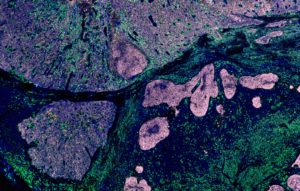APPLICATIONS OF TECHNOLOGY:
- Identifying clinically significant subtypes for different tumors
BENEFITS:
- Provides new knowledge that improves diagnosis and optimization of treatment
- Cost-effective compared with hematoxylin and eosin (H&E) stained histology sections
- Promises significant clinical value combined with well-known factors (i.e., clinical factors and mutation factors)
BACKGROUND:
Evidence suggests that Lower Grade Glioma (LGG) is a heterogeneous disease. The objective of this invention was to personalize the diagnosis and care of LGG patients by developing morphometric subtypes. Uncovering the molecular signatures underlying these subtypes was made possible by leveraging machine learning and multi-center cohorts.
TECHNOLOGY OVERVIEW:
Using an unsupervised representation machine learning technique, Berkeley Lab researchers defined two cellular morphometric subtypes from The Cancer Genome Atlas (TCGA) lower-grade glioma patients. The subtypes were externally validated in two international cohorts. The two subtypes show a robust and significant association with overall survival of LGG patients across all three independent cohorts. A nomogram based on subtypes has been developed and validated to predict the 3- and 5- year survival probability of LGG patients for clinical application. LGGs with poor prognosis subtype were characterized by a higher total mutation burden, contained higher frequencies of somatic copy number alteration, and increased levels of tumor-infiltrating lymphocytes, which was further confirmed by immunohistochemistry staining.
The framework for cellular morphometric subtype discovery used in the LGG application can be applied to other types of human cancers.
DEVELOPMENT STAGE: Proven principle
RELATED TECHNOLOGY:
Genetic Barcodes for Cancer Prediction and Prognosis IB-2897
Protease-based Cancer Screening Using Nanoliter Samples IB-2240
PRINCIPAL INVESTIGATOR:
Hang Chang
STATUS: Patent pending
OPPORTUNITIES: Available for licensing or collaborative research.
